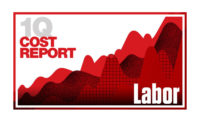1Q 2025 Cost Report: Slow Decline In Used Iron Prices Seen as Demand Slips

While sliding prices for construction equipment at resale and auction could signal softening demand, there are also concerns that tariffs could strain a highly globalized supply chain. “Used construction equipment values have been declining steadily for the past year; there’s been a 1% drop or so every month,” says Sam Pierce, sales engineer with industry analyst EquipmentWatch.
“And year-over-year construction values are down 8%, which is a pretty significant drop.”
Resale and auction data tracked by EquipmentWatch has seen prices slowly deflating in both the construction and lift categories over the past year. Values have also been declining while the age of machines has been fairly consistent, a sign of possibly slacking demand rather than a glut of older machines.
Related link: ENR 2025 1Q Cost Report PDF
Subscription Required
“It’s little bit strange to see the values drop and the age stay about the same, and the usage is lower as well,” says Pierce. “You’d expect if the values were dropping it would be older or more heavily used equipment, but that’s not what we’re seeing here.”
The slide in prices is, however, coming down from a plateau that formed during the COVID-19 pandemic, when equipment was difficult to source. But the times of 18-month lead times for new equipment on backorder have also passed, notes Korin Hasegawa-John, managing principal at consulting firm Ducker Carlisle. “That time of order books being full is over—manufacturers can deliver quickly now if they need to,” he says. And with the global supply chain back up and running, there is a slight glut in the supply of machines in the U.S. right now. “We don’t see the cycle right now as being abnormal.”
Looming Specter of Tariffs
Looking at the possibility of new tariffs from the Trump administration impacting the construction equipment market, Hasegawa-John sees original equipment manufacturers (OEMs) taking a page from 2017. “Like back then, some entities will seek waivers, and there will likely be winners and losers based on exemptions and waivers granted [from tariffs].” There are other options as well, and Hasegawa-John says rather than rase their base prices to reflect tariff costs, many OEMs added a tariff surcharge line item to new purchases during the first Trump administration. Those kind of extra fees may make a comeback if input costs are impacted, he says. “Many OEMs have various strategies and plans ready to go, but they’ve not made any moves yet.”
Slowing demand may also discourage OEMs from reorganizing their global supply chains, and as Hasegawa-John puts it, there isn’t much onshoring or nearshoring left that would bring production back to the U.S. “We think OEMs have already done most of low- and medium-hanging fruit around localization [of their supply chains].”
Manufacturers such as Caterpillar Inc. have already been absorbing some of that softening demand for new heavy equipment over the course of 2024. The Irving, Texas-based OEM recently reported a 5% year-over-year decline in sales and revenue for the fourth quarter, including an 8% decline in its construction segment alone. Caterpillar CEO Jim Umpleby said on an earnings call Jan. 30 that “although we anticipate the combined non-residential and residential construction spend to remain similar to 2024 levels, our current planning assumptions reflect lower demand for new equipment.”


.jpg?height=200&t=1640294757&width=200)
